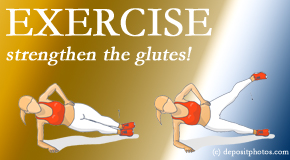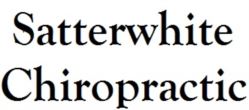Oxford Gluteus Muscle Weakness Helped by Exercise: Planks
The glutes are for more than just sitting! They need to be strong and supportive to keep us, especially those of us who suffer with Oxford back pain, walking, balanced, up-right. Satterwhite Chiropractic takes gluteal muscle strength seriously, particularly the gluteus medius muscle, one of the more prominent supportive spine muscles along with the gluteus maximus, tensor fascia latae, lumbar multifidus, external oblique, erector spinae, and rectus abdominus. So many muscles, so little time to discuss them all. Your Oxford chiropractor is focusing on the gluteal muscles this month. More to come on the others!
FOCUSING ON WEAK GLUTEUS MUSCLES WITH SIDE PLANK OR BRIDGE
When supportive muscles are weak – gluteus maximus, gluteus medius, multifidus and transverse abdominus – doing exercises that strengthen those while not activating others like the erector spinae and tensor fascia latae is desired. Side bridge while lifting the dominant leg is one exercise that demonstrated its ability to be good in activating the gluteal muscle over tensor fascia latae muscle. (An aside: Back bridge exercise showed itself helpful in strengthening the multifidus muscle.) (1) A variation of side plank is the side-sling plank. Researchers found that it improved gluteus medius strength post-injury. Side-sling plank with hip medial rotation proved itself superior for patients with gluteus medius weakness but stronger tensor fasciae latae. (2) Side bridge exercises were documented to strengthen hip, trunk, and abdominal muscles as well as challenge trunk muscles without high lumbar compression, an important point for back pain sufferers like those Satterwhite Chiropractic care for in our Oxford chiropractic office. Another variation that was described as being superior to the others for strengthening a weak gluteus medius muscle was the side bridge with knee flexion. (3) When glute muscles are weaker than their adjacent muscles, exercises focused on activating the gluteus max and gluteus medius without involving surrounding muscles like the tensor fascia latae, etc., are vital. One simple exercise that activated the gluteus maximus and gluteus medius muscles while reducing the impact of the tensor fascia latae muscles was the clam exercise. (4) With such a variety of exercises to choose from, allow your Oxford chiropractor to help isolate which of your supportive muscles are weak and decide which exercises - natrual parts of chiropractic care - are best to strengthen them.
CONTACT Satterwhite Chiropractic
Listen to this PODCAST with Dr. Robert Krause on The Back Doctors Podcast with Dr. Michael Johnson as he describes care of a patient with degenerative disc disease and back pain who attained relief with The Cox® Technic System of Spinal Pain Management that included exercise.
Schedule your Oxford chiropractic appointment with Satterwhite Chiropractic today. Don’t just sit on your weak glutes. Strengthen them, so they can best support you!

